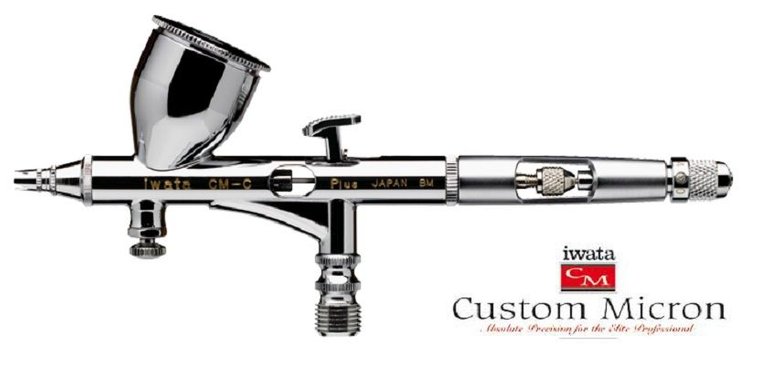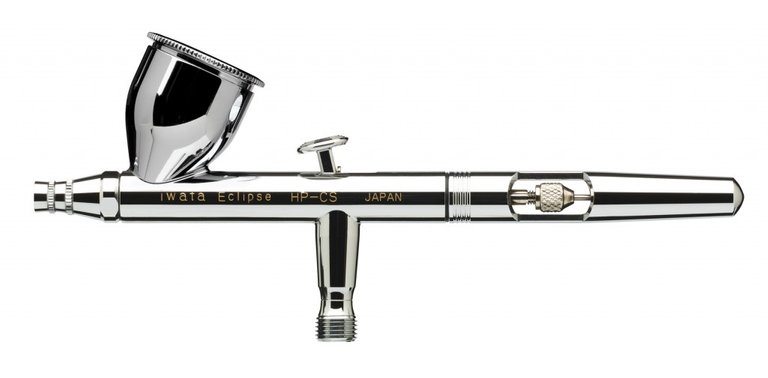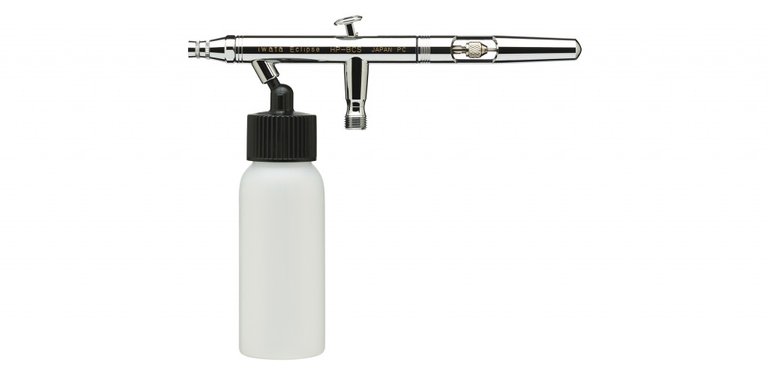Airbrush Tutorial Part 1 – What Airbrush Should I get?

This is the first part of a series I will be creating to help new aspiring airbrush artist or hobbyists learn about this amazing tool. Please support me by upvoting and following me to stay up to date with future posts.
A common question among those new to airbrushing is “What airbrush should I get?” This isn’t always an easy question to answer, it’s broad and there are a lot of different factors and the answer changes depending on who you ask. In this tutorial/informative post, I want to clear up the differences in the 3 main feed types of airbrushes being gravity, syphon and side feed. I will not cover externally mixed or single action airbrushes, 99% of airbrush uses will be covered by those 3 types of airbrushes. Part 2 will include airbrush brands, pricing of parts and where to source them.
Airbrush Types
Gravity Feed

Gravity feed airbrushes contain a cup on the top of the airbrush body between the trigger and the head assembly. It is called a gravity feed airbrush as it uses gravity to force the paint down the nozzle ready to be released once the trigger is pulled back.
What are the benefits of using a gravity feed airbrush?
They enable you to run your airbrush at a very low PSI given your paint has been reduced or thinned down enough. This is great for detail work or getting those super soft tones in place. That being said, fine detail and tone can be achieved with any style airbrush given your level of airbrush control is good enough. Don’t think you are limited to a gravity feed airbrush for detail.
They are more convenient to hold and use as they do not have a large bottle underneath them like on a syphon feed airbrush, there is nothing to get in the way when holding your airbrush up close at different angles.
The colour cup won’t fall of, and given you are using the lid, you won’t spill any paint. Sometimes on a syphon feed airbrush the bottle can fall off and splatter paint on your artwork, this isn’t fun. Or on a side feed airbrush the cup can come loose is rare cases and make a mess.
What are the disadvantages?
Changing colours in a gravity feed is annoying. You have to clean it out between every colour (this is where a syphon feed really shines). For this reason, I primarily use gravity feeds for single colour artworks.
They don’t hold a lot of paint, this can be a disadvantage depending on artwork size.
Some say the colour cup gets in the way of your vision…I personally don’t think so, but maybe for you it could be an issue.
Syphon Feed Airbrushes

Syphon feed airbrushes require a bottle of paint to be attached at the outlet underneath the airbrush, also between the trigger and head assembly. These airbrushes work by using a vacuum around the fluid nozzle which sucks paint up from the bottle. I won’t go into the exact science behind how these, all you need to know is how they differ to gravity and side feeds.
What are the advantages of a syphon feed airbrush?
Colour changes are quick! Remove the bottle, flush out any remaining paint with water or reducer, attach the new bottle and away you go.
Bottles come in different sizes, you can have a little bit of paint or a lot of paint.
Nozzle sizes generally come in larger sizes on syphon feed airbrushes, you can crank up the PSI and do some really large areas such as murals with a syphon feed airbrush.
What are some disadvantages?
You normally need to keep the PSI a bit higher compared to a gravity or side feed. This is because of how they work. They need to pull paint up from the cup to the nozzle, unlike the gravity which already has paint sitting at the nozzle ready to go.
This will also require you to have an air compressor with enough power to provide the air pressure.
They generally do not come with small tip sizes like they do with the gravity feed. An exception will be highlighted in the next part when I go over brands.
Buying good quality bottles can be expensive
Side Feed Airbrushes
.jpg)
Side feed airbrushes you will find are almost exclusively used for fine art, at least that’s what I have noticed but they are not limited to that exclusive use by any means. I will tell you this, I bought a high end and expensive gravity feed airbrush and now wish that I bought the side feed version instead. Side feeds work by attaching a small paint cup to the side of the airbrush, now you might wonder “but how does it work?”. It works by using the weight of the paint to push it over to the airbrush fluid nozzle, it kind of behaves more like a gravity feed airbrush and carries the same benefits apart from the fact that the cup is detachable. It is also possible to get large side feed bottle that hang down from the mounting hole in the side which allows you to use more paint, I have never seen anyone do this before though.
So what are the advantages?
The advantages are the same as the gravity feed (aside from the fact that in very rare cases the cup might fall off).
They also bridge the main difference between gravity and syphon, you could use multiple side feed cups and change them out as you require a new colour. Awesome!
You have better vision of your artwork as there is nothing on top of the airbrush.
Any disadvantages?
Probably wouldn't use it for larger areas like murals.
There really isn’t anything else as they embody everything between the syphon and gravity feed airbrushes. All I can think of is that there are only a couple of manufacturers that make them which I will cover in part 2 and they are both very different.
Thank you very much for making it through this tutorial, I really appreciate it. In the next part I will go over airbrush brands, the only ones you should worry about. I will also show you some of my personal airbrushes so you can get a little insight into what I use to produce artworks.
Please upvote and follow if you found this useful or found the content well written.
Cheers!
Josh
I did some airbrushing back in high school. they are fun to use. Thanks for the indepth tutorial going into each type of airbrush and the benefits of what each is good for. Great Post.
Thanks for reading
nice one...
Thank you
Do feel free to check my blog for a short story on family versus office, quite interesting. Comment & follow me for more updates. Thanks
I love airbrushing!!!
Haha me too! Thanks for reading
Iwata Microne is an airbrush monster has a level of detail so precise that with the work hyperrealism or photo retouching and you can paint a face in a coin